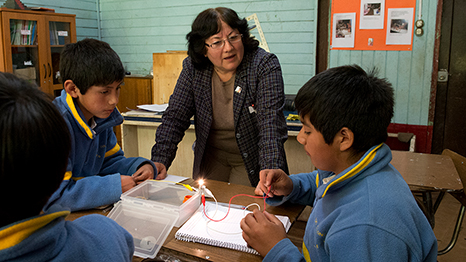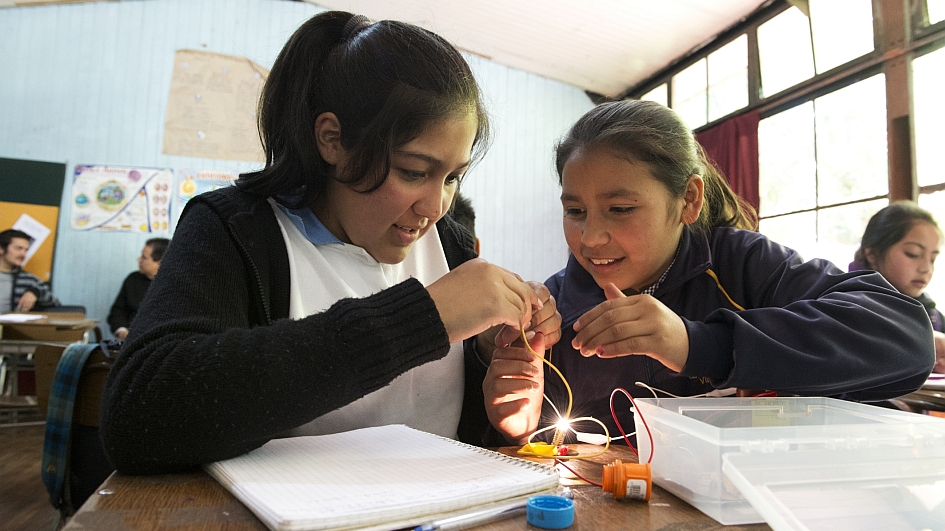
»Scientific experiments are fun and give kids an immediate sense of achievement.«
Elementary School Rayen Lafquen in Chile
Inquiring young minds – Experimento in Chile
Domingo is 14 years old, the best in his class and the second-youngest of twelve siblings. His parents own just a narrow strip of land they farm around their little wooden house by the river; the money they earn is enough to survive, but hardly to give so many children an education. Yet Domingo knows what he wants to become: an electrical mechanic. “Since we did the experiment with the electric circuit and the bulb lit up.”
"Do you actually know what air sounds like?"
This morning the teacher Cristina Navarrete begins the lesson at the Rayen Lafquen elementary school with an odd question: “Do you actually know what air sounds like?” Twenty children’s faces light up with curiosity and are then full of enthusiasm after each child has blown up a balloon and let the air screech as it exits through the mouthpiece. A wonderful racket reverberates through the classroom from the demonstration of how sounds are produced by air pressure.
That game is one of many in the Experimento kit: It contains simple materials such as filter paper, straws, bulbs, glass beakers – and, of course, brightly colored balloons. Surprising what can be done and learned with these things. For example, when you can mess up water with all sorts of muck and then look at the residues you have collected using a coffee filter under a magnifying glass.

The Experimento kit is already part of the furniture
The school where the kids can make a lot of noise and mess consists of a wooden house in which four teachers teach around fifty pupils from the Mapuche Indian tribe in the south of the country near to the town of Villarica. Like the cast-iron stoves used to heat the four classrooms, the Experimento kit has been part of the furniture since the summer of 2013, when it was introduced by the teacher Cristina Navarrete. In the past year she has attended four seminars on this program staged by Siemens Stiftung and the Catholic University PUC in Santiago de Chile. “There I experienced the same as my pupils: Scientific experiments are fun and give kids an immediate sense of achievement. Now we think up ones on our own, for example a phone that’s just two plastic beakers connected by a piece of string.”
In 2011 Ulrike Wahl, at the time Managing Director of Siemens Stiftung, now working for it as a consultant in Latin America, embarked on a search for suitable partners and locations for Experimento in Chile. Three regions were chosen: First, the city of Santiago, where among other things the schools of the Sociedad de Instrucción Primaria are situated in districts where there is a high crime and unemployment rate. Second, the Antofagasta region in the Atacama desert in the north of the country, where people generate a lot of wealth for Chile in the copper mines, but where there is an urgent need to catch up when it comes to education. And finally Araucanía in the south, the home of the Mapuche Indians, who live far flung in the hilly, densely forested region. The key issues here are integration and intercultural dialog. To guarantee an education for every child, there are countless one-room schools with just a single teacher and ten or twenty children of different ages.
Around 400 teachers have already been trained
In the first phase, seventy of around a thousand schools in Araucanía have now been integrated in Siemens Stiftung’s project. Siemens Stiftung and PUC have together trained four hundred teachers, who return to their schools as multipliers with new didactic approaches and the Experimento kits.
Last week Cristina Navarrete’s class dealt with the question as to what material is suitable for conducting electricity. The children eagerly tried to conduct electricity from a battery via rubber bands, matches and strips of plastic to the bulb from the Experimento kit. In vain. Initially without success. Only Domingo realized right away that only metal can conduct the electricity between the small clamps and immediately explained it to his class mates. The joy was huge when a screw, a floor plate and even the stove proved to be suitable media to let the bulb light up.
May 2014


